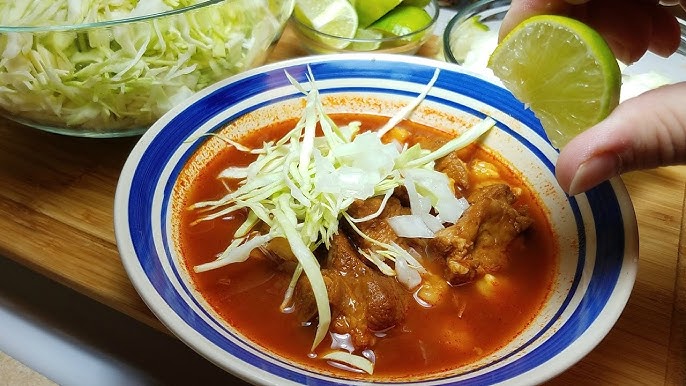Pozole Recipe: Pozole, a beloved traditional Mexican soup, is a flavorful celebration of heritage and communal dining. With a history dating back to ancient Aztec and indigenous cultures, Pozole has evolved into a dish enjoyed throughout Mexico and beyond. Known for its hearty texture and rich flavors, Pozole is built around hominy—a special type of corn that’s treated to achieve a unique texture. Combined with tender meat and seasoned with an array of chiles and spices, Pozole is a versatile dish that varies by region, appearing in red, green, and white versions.
In this guide, we’ll cover how to make the three primary types of Pozole—Rojo (Red), Verde (Green), and Blanco (White)—with simple, detailed steps that will help you recreate this dish at home.
Ingredients Required
Making Pozole is easier when you have the right ingredients. Here’s what you’ll need:
- Hominy: Canned hominy is a convenient option, but dried hominy adds a more authentic touch.
- Meat: Traditionally, pork shoulder or pork butt is used, though chicken is also a popular alternative. You can also mix in other cuts for added depth.
- Chiles: For Pozole Rojo, dried guajillo and ancho chiles give it a deep red color. Pozole Verde uses green tomatillos, cilantro, and green chiles.
- Herbs & Spices: Garlic, onions, bay leaves, and Mexican oregano for seasoning the broth.
Optional Ingredients:
- Fresh herbs like epazote or cilantro (especially for Pozole Verde).
- Radishes, cabbage, or lettuce for garnish.
- Lime, for added brightness.
Types of Pozole
Each Pozole variation offers a unique experience:
- Pozole Rojo (Red Pozole): Defined by its vibrant red sauce from guajillo and ancho chiles, it’s mildly spicy and savory.
- Pozole Verde (Green Pozole): Fresh and tangy, made with tomatillos and green chiles, it’s a favorite in the southern regions of Mexico.
- Pozole Blanco (White Pozole): A simpler, more subtle flavor profile that lets the hominy and meat shine without additional sauces.
Step-by-Step Guide to Making Pozole
Step 1: Preparing the Hominy
- For Dried Hominy: Soak it overnight in water. Drain, then cook in fresh water for about 2-3 hours until the kernels puff and become tender.
- For Canned Hominy: Simply rinse and drain well.
Hominy should be soft but slightly chewy when ready, adding texture to the dish.
Step 2: Preparing the Meat
- Cut pork shoulder or pork butt into medium-sized pieces, trimming any excess fat.
- Place the meat in a large pot with water, and add onions, garlic, bay leaves, and salt.
- Bring to a simmer and cook on low for about 1-2 hours or until the meat is tender enough to shred.
Tip: Skim any foam that rises to the top during cooking for a clear broth.
Step 3: Creating the Broth Base
The broth is the backbone of Pozole’s flavor. Add a handful of Mexican oregano, more garlic, and bay leaves as it simmers. This slow-cooked broth will blend flavors together and set the stage for the final dish.
Step 4: Preparing the Sauce (for Red and Green Pozole)
For Pozole Rojo:
- Toast guajillo and ancho chiles on a skillet, then soak in hot water until soft.
- Blend the softened chiles with garlic, onion, and a bit of the soaking water.
- Strain the sauce for a smooth consistency, then add it to the broth.
For Pozole Verde:
- In a skillet, roast tomatillos, garlic, onion, and green chiles until softened.
- Blend the roasted ingredients with fresh cilantro and epazote.
- Add the sauce to the broth and let it simmer for a few minutes.
Step 5: Combining All Elements
With the meat tender, broth rich, and sauce prepared, combine all components:
- Add the hominy, shredded meat, and sauce (if using) to the pot.
- Simmer on low for another 30-45 minutes, allowing the flavors to meld.
Taste and adjust seasoning with salt, pepper, or extra herbs as needed.
Cooking Tips for Authentic Pozole Flavor
- Roast Chiles Properly: Slightly charring chiles and tomatillos enhances the sauce.
- Low and Slow Cooking: Pozole flavors are at their best when simmered gently.
- Use Fresh Ingredients: Fresh herbs, high-quality meat, and authentic spices make a big difference.
Traditional Garnishes and Accompaniments
Pozole shines with garnishes! Traditional toppings include:
- Shredded Cabbage or Lettuce: Adds a crisp texture.
- Sliced Radishes: Brightens the bowl with color and crunch.
- Onions and Cilantro: Freshness to balance the richness.
- Lime Wedges: A squeeze of lime enhances flavor.
Serve with tostadas, avocado slices, or sour cream for an even richer experience.
Pozole Recipe Variations
- Vegetarian Pozole: Substitute mushrooms or jackfruit for meat and use vegetable broth.
- Vegan Pozole: Omit animal products, relying on beans or tofu for protein.
- Regional Variations: Some regions add seafood or special local spices.
Common Mistakes to Avoid
- Overcooking Hominy: Aim for tender but not mushy hominy.
- Undersalted Broth: Salt should be added gradually to maintain the broth’s depth.
Storing and Reheating Pozole
Store Pozole in an airtight container in the refrigerator for up to 3 days. Reheat gently on the stove, adding a bit of water if the broth has thickened too much.
Pozole Nutritional Information
Pozole is generally a nutritious dish, containing protein, fiber, and essential vitamins from hominy and vegetables. However, portion size matters, as traditional Pozole can be high in calories.
Pozole Serving Suggestions
Pozole pairs well with other Mexican sides like:
- Tostadas or Tortillas: Adds a satisfying crunch.
- Mexican Rice: Complements Pozole’s rich flavors.
- Mexican Beer or Agua Fresca: Refreshing beverages to round out the meal.
FAQs about Pozole Recipe
1. What is Pozole?
Pozole is a traditional Mexican soup made primarily from hominy (dried corn kernels), meat (usually pork or chicken), and seasoned with various spices. It’s commonly garnished with toppings like shredded lettuce, radishes, avocado, and lime, making it both flavorful and versatile.
2. How do I make Pozole from scratch?
To make Pozole, start by cooking the hominy and meat in a large pot, typically with garlic and onions. Once tender, add spices like cumin and chili powder for depth. Simmer until everything is well-cooked, and finish with fresh toppings. Check out our full Pozole recipe for step-by-step guidance.
3. What toppings go well with Pozole?
Popular toppings for Pozole include shredded lettuce, sliced radishes, diced onions, cilantro, avocado, and lime wedges. These toppings add freshness and crunch, enhancing the soup’s flavors.
4. Can I make Pozole ahead of time?
Yes, Pozole is perfect for making ahead, as the flavors deepen when it sits. Simply reheat on the stovetop and add fresh toppings before serving.
5. What is the difference between red, green, and white Pozole?
The color of Pozole varies based on the ingredients. Red Pozole uses dried red chiles, green Pozole includes tomatillos and green chiles, while white Pozole keeps the base simple with no added colors. Each variation has a unique taste profile but follows a similar preparation method.
Conclusion
Making Pozole at home brings the heart of Mexico into your kitchen, a warm, satisfying dish perfect for gatherings or family dinners. With patience and attention to detail, you’ll create a Pozole that’s both delicious and authentically rich in flavor.



